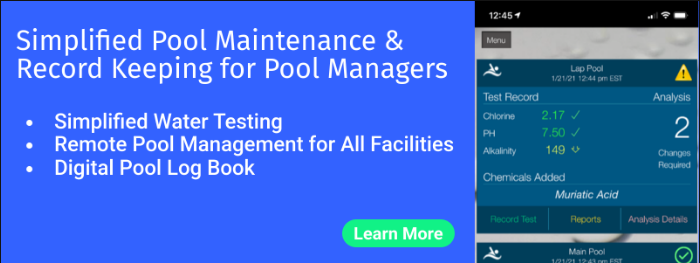We all love a fun or relaxing swim–especially on a hot summer day–and public pools across the country ensure we can all have access to this pastime. Yet as a body of water open to the public that often sees hundreds of swimmers in a day, we’ve all wondered: are public pools clean? Are they really always safe to swim in?

Ahead, we’ll cover some of the universal rules and regulations public pools must adhere to, who checks to ensure cleanliness, some red flags to watch out for, and, steps to take as a commercial or public pool owner to ensure your guests never have to wonder if your pools are safe and clean to swim in.
How Public Pools Stay Clean
Across the country, the rules and regulations for public pools vary state by state, and sometimes even county by county. If you want to be sure of the specifics for any pool you’re visiting or managing, it’s best to check those first.
However, because of these different variations and the difficulties they can present, the CDC recently introduced a single, science-based reference guide–the Model Aquatic Code–intended to standardize pool codes nationwide. Many jurisdictions have begun to adopt this code as their own, which helps make standards clear for the design, operation, and management of pools, including how water chemicals must be balanced to provide safe, swimmer-friendly disinfection, and how often those chemicals must be tested.
Another shift we’re seeing is more and more states defining a public pool to include hotel pools, apartment pools, HOA pools, gyms, schools, and essentially any aquatic venue that’s open to communities, members, guests, and members of the public that can be accessed, with or without a fee.
This means that more and more across the US, unless it’s a private residential pool, the pools we’re accessing to swim in are being defined and governed as public pools.
For swimmers, this is generally good news. It establishes a more clarity for the safety and cleanliness requirements we can expect from nearly all pools.
Public pools are advised to, among other requirements:
- Modestly overdesign recirculation systems in order to adequate filter for contaminants and human water borne pathogens and circulate water
- Maintain proper chemical use and ventilation
- Consistent cleaning and continuous disinfection of the pool and its systems
- Rapid response to, removal and remediation of contaminants (fecal, blood, and vomit)
- Maintain safe water temperatures, dependent on the use of the pool and the type of swimmers
- Maintain optimal water chemical levels and pH and test water quality parameters regularly
Again, while testing frequency may vary by state or county, in general, the CDC advises testing for Free Chlorine, Combined Chlorine, and pH at the pool’s opening and closing and every two hours in between. Other parameters, such as pool stabilizer levels, may be tested less frequently, as in on a weekly or monthly basis.
Each pool is responsible for recording those test results and any related chemical adjustments to the water. These records are then checked during routine Health Department inspections, in addition to the pool and the facility itself. Failure to record and preserve these records puts a public pool in non-compliance with the Health Department, and forged records are often easy for Health Inspectors to spot. In general, the local Health Department is responsible for ensuring pools are following codes, laws, and requirements for safety and cleanliness.
How to Spot a Public Pool That’s Not Clean or Safe to Swim In
However, Health Departments are often understaffed and stretched beyond their capacity, which can make it difficult for them to perform routine inspections as often as needed.
That’s why, as a guest at a public pool–whether it’s a community pool or a hotel pool–it’s also good practice to understand what to look for to ensure the water is safe and clean to swim in:
- How does the water look? Is it cloudy or green? If this is the case, it’s a clear indicator of unbalanced water that is not properly disinfecting and controlling bacteria, viruses, and algae.
- Can you see the drain at the bottom of the pool? Again, if the water is so cloudy the drain at the bottom of the pool in the deep end isn’t visible, this water is not safe to swim in. This is not only because of the risk for disease and irritation, but also because water that isn’t clear makes it far more difficult for lifeguards and parents to do their job and ensure swimmers are safe.
- How does the pool smell? If it smells off or too strongly of chlorine, this is another sign that the chemical balance is off in the pool and you should not get in.
We also recommend buying an inexpensive pool test kit with strips to perform your own water test. While these aren’t allowed for routine use by public pools in their own water testing, as they’re not accurate enough, they can help give you clear indicators whether or not there is enough free chlorine in the pool for sanitizing.
Steps for Public Pool Managers and Operators to Take
If you manage or operate a public pool, the last thing you want is for your pool to develop a reputation as unclean, leading to a loss of visitors and business. Be familiar with your local and state codes and requirements, and compare them against the CDC’s Model Aquatic Code, which is updated regularly.
Ensure you are doing everything you need to from a health and safety perspective, including maintaining safety supplies, posting clear signage about pool rules–including requesting guests shower before entering the pool. Remove debris promptly, especially after rain and storms, and brush the pool regularly to prevent algae build-up.
Finally, ensure you and staff are regularly trained on how to properly test water parameters. Using water test kits with high degrees of accuracy will help ensure you maintain water that is clean, balanced, and non-irritating, as well as keep your chemical use and costs under control.
Because the chemical calculations to keep water in balance are complex, we recommend using our PoolShark H2O app which does the calculations for you, so you or staff know exactly how much of which chemical to add. It then locks these records automatically, ensuring managers can access them remotely and that they’re Health Department compliant. Plus, when combined with the LaMotte SpinTouch test kit, tests are performed in 60 seconds for all parameters, with the risk for human error all but eliminated.
Making these steps routine and performing them to a high degree of accuracy will keep your pool water sparkling, clear, clean, and healthy, so guests never have to wonder about cleanliness.



